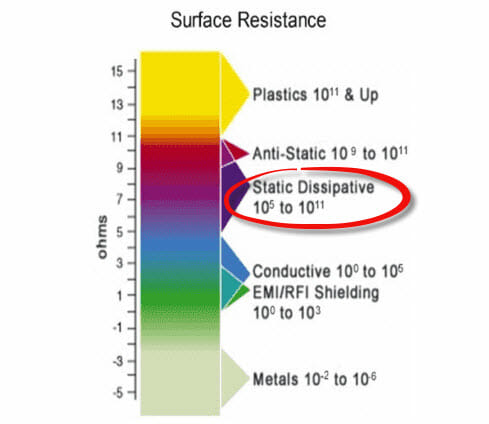Initial 3D Printed Part ESD Test Results:
ESD safe materials are those that prevent electrostatic charges from building up in a component. When you are shocked by a doorknob that is an ESD (Electrostatic Discharge). Those charges can damage electrical components. So all material in a facility that manufactures electronics have to be ESD Safe. This can be achieved with various ESD Safe 3D Printing Options we will cover on this page. But first lets go through some terms and there definitions.
- Electrostatic Discharge Terms, see surface resistance chart below for visual reference.
- Conductive:
- Conductive materials have a low electrical resistance; thus electrons flow easily across the surface or through these materials. Charges go to ground or to another conductive object that the material contacts.
- Dissipative (ESD safe):
- Dissipative materials allow the charges to flow to ground more slowly in a more controlled manner than with conductive materials.
- Ant-Static:
- Anti-static materials are generally referred to as any material which inhibits triboelectric charging. This kind of charging is the buildup of an electric charge by the rubbing or contact with another material.
- Insulative:
- Insulative materials prevent or limit the flow of electrons across their surface or through their volume. Insulative materials have a high electrical resistance and are difficult to ground, thus are not ESD safe materials. Static charges remain in place on these materials for a very long time.
- Conductive:


When evaluating materials for ESD performance, the most important property is usually the surface resistance, measured in ohms. Conductive materials – typically metals – have a surface resistance generally less than 103 ohms, insulators such as most plastics are rated at greater than 1012 ohms, and ESD materials fall in the mid-range, at 106 to 109 ohms.
The best way to fully grasp ESD safe 3D printing materials, is to understand where ESD safe plastics have been used. There are three primary uses for ESD safe plastics:
- Electronics manufacturing tooling:
- Static shock Prevention
- EXAMPLE: ESD safe jigs and fixtures for printed circuit board manufacturing
- Materials in a combustible/explosive environment:
- Static Spark Prevention
- EXAMPLE: All the plastic parts near a gas pump
- Nuisance static charge elimination:
- Static Cling Prevention
- EXAMPLE: powder conveying materials



The biggest demand is usually found in the electronics manufacturing industry where lots of new electronic devices are being developed and manufactured each day. Every one of these devices requires a multitude of custom jigs, fixtures, pallets, nests and assembly aids to produce. Traditionally these components are made in medium to low volumes with traditional subtractive manufacturing techniques (CNC milling). This results in long lead times and very expensive tooling charges. Additive Manufacturing is changing all of this by allowing manufacturers to design jigs and fixtures to be 3D printed with advanced engineering-grade materials that meet ESD surface resistance requirements. Lead times can be reduced from weeks to days and multi-component assemblies can be reduced into a single 3D printed part.
Options for ESD Safe 3D Printed Parts
There are 3 options for making ESD safe 3D printed parts, ABS-ESD7 material printed on an FDM machine, ESD Resin material printed on an Formlabs SLA, or Nylon 12 material printed on and HP MJF machine and coated in an ESD safe coating. Each of these options has its pros and cons which we will cover here.
- ABS-ESD7 printed on an FDM machine
- Pros:
- The ESD material is formulated into the ABS plastic making it wear resistant
- FDM machines can print large parts (36″ Long x 24″ wide x 36″ tall)
- Cons:
- The parts have a rough surface finish and are weak in the Z direction of print orientation
- Things like layer direction and placement of dissolvable support can adversely effect the ESD safe characteristics of the part and must be proved out with a prototype
- Conclusion: This material / process is best suited for very large parts in low quantities that need to be ESD safe and can have a rougher surface finish
- Pros:
- ESD Resin printed on an Formlabs SLA machine
- Pros:
- The ESD material is formulated into the resin making it wear resistant
- SLA machines can print extremely detailed and very accurate parts
- Cons:
- This printer has a small bed size so part size is limited (5.7″ × 5.7″ × 7.3″)
- This is our least heat resistant ESD material at 143.9 °F so its not well suited for high temp applications like soldering
- Conclusion: This material / process is best suited for small parts with high detail in low quantities that need to be ESD safe and will be used in room temp environments.
- Pros:
- Nylon 12 material printed on an HP MJF machine and then coated in Licron Crystal ESD-Safe Coating
- Pros:
- The parts are extremally strong and wear resistant
- The coating can be easily reapplied in the field if needed due to wear or damage
- The coating is EXTREAMLY ware resistant (see video below)
- Cons:
- In extreme situations like sand blasting environments the coating can be stripped off the part its applied to
- The coating is applied line of sight and thus can’t coat internal features of a part
- Conclusion: This material / process when coated with an ESD safe coating is well suited to all nesting applications for machine builders and anyone who needs a medium to high quantity of electronic enclosures with ESD safe characteristics
- Pros:
Need help determining what is the best ESD Safe 3D Printing option for your project? Feel free to reach out to our sales engineers for a free evaluation of your project: Sales@Forerunner3d.com
Extreme Wear Testing of Nylon 12 With a ESD Safe Coating Applied
Curious about using 3D Printing for pogo pin nests? Check out this page that outlines all the pogo pin related testing work we have done.